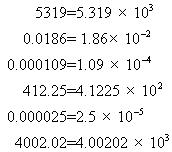Home >> Number - Standard Form
Standard Form is a convenient method for writing out very large or very small numbers.
The general form is :
$ {\Large{N \times 10^n}} $
where 'N' is a number equal to, or more than one, but less than ten,
$ {\Large{ 1 \le N < 10}} $
and 'n' is the power to which 10 is raised.
Example #1 - What is 149550 in standard index form?
Take the first number(1) and place a decimal point after it. Continue writing down the other numbers behind. This is 'N'.
N = 1.49550
Now count the number of numerals there are after the decimal point.There are 5.This is our value for 'n' in the expression.
Therefore 149550 becomes ![]()
Example #2 - What is 0.0000218 in standard index form?
Write out the first number after the line of zeros(2), and place a decimal point after it. Continue writing down the other numbers behind. This is 'N'.
N = 2.18
Now count the number of zeros between the original decimal point and the first number(2).
Add '1'. This number gives you the value of 'n'. In this case 4+1=5.
But because we are dealing with a number less than one, the index 'n' is negative.
The index is '-5'.
0.0000218 becomes ![]()
more examples ...

[ About ] [ FAQ ] [ Links ] [ Terms & Conditions ] [ Privacy ] [ Site Map ] [ Contact ]
